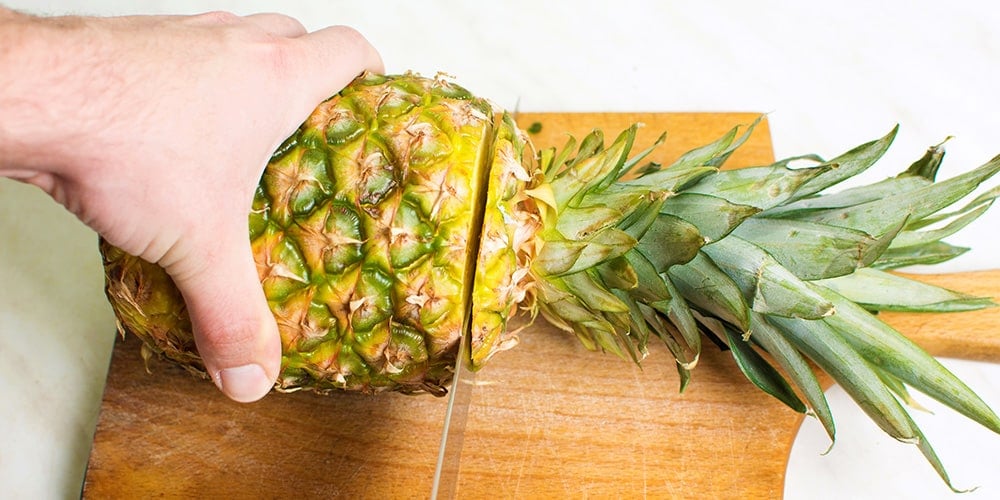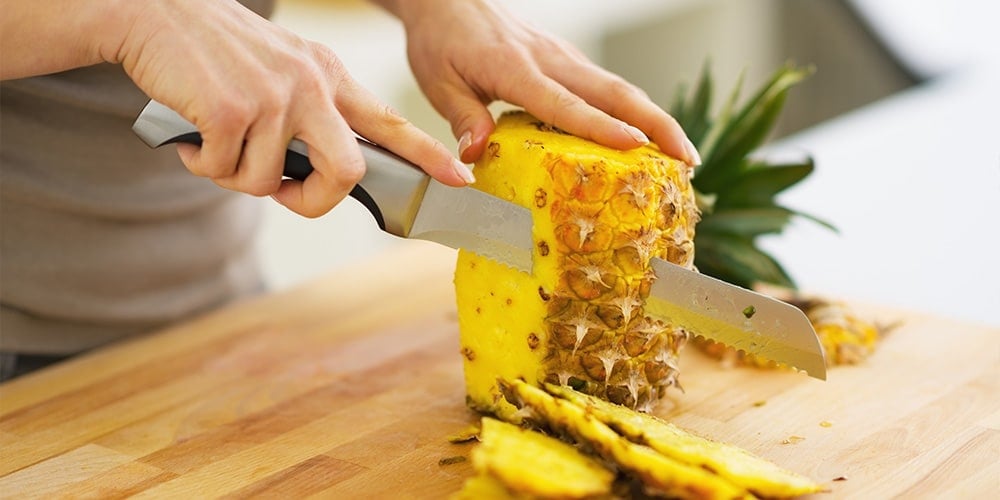Fresh pineapple is a delicious fruit that instantly elevates a plain old fruit platter to a tropical treat. But before you can enjoy the sweet, tart fruit inside, you have to know how to cut the pineapple the right way. If you want to add pineapple to your menu but you're intimidated by the rough skin and spikey leaves, this tutorial is for you. We'll show you the best way to cut a pineapple, and the best part is you don't need any special knife skills to get started.
The Best Way to Cut a Pineapple
Watch the video below for a step-by-step walkthrough of how to cut a pineapple:
How to Know If a Pineapple Is Ripe
Before you start cutting, make sure the pineapple is perfectly ripe. Otherwise, you'll have created more food waste by prepping a tasteless pineapple. Here are some simple tips to help you identify a pineapple that's sweet and juicy:
- Color of the Skin: A ripe pineapple should have a vibrant golden-yellow color, indicating that it is sweet and juicy. Avoid pineapples with green or brown patches, as they may not be fully ripe.
- Squeeze the Fruit: A ripe pineapple should have a slight give when pressed, but it should not feel too soft or mushy. If the pineapple feels firm, it may need more time to ripen.
- Sniff Test: Another way to check for ripeness is to smell the bottom of the pineapple. A sweet, tropical aroma indicates that the pineapple is ripe and ready to eat. If there is no scent or if it smells fermented, the pineapple may be overripe.
- Check the Leaves: Lastly, look at the leaves on top of the pineapple. While the leaves are not always the best indicator of ripeness, they should be green and healthy-looking. Wilted or dried-out leaves may suggest that the pineapple is past its prime.
By using these simple tips, you can easily determine if a pineapple is ripe and perfect for cutting. Keep reading to learn the best way to cut your pineapple.
The Easiest Way to Cut a Pineapple

You just need three items to cut a pineapple into chunks - a sharp chef's knife, a paring knife, and a cutting board. We'll even teach you how to remove the core without a pineapple corer.
- Start with a ripe pineapple and place it on its side on the cutting board.
- Use a chef knife to cut off the crown of the pineapple, about 1/2" to 1" from the top. Then cut off the bottom of the pineapple.
- Now that you have a level bottom, place the pineapple right side up on the cutting board.
- Place your knife on the outer edge and carefully slice downward to remove as much of the skin as possible, working your way around the pineapple until all the skin is removed. If you want to leave the skin in place for presentation purposes, skip this step.
- If there are eyes (round pieces of skin) still left on the pineapple, you can remove those with a paring knife.

Pineapple Chunks:
- With the pineapple still right side up, cut it in half lengthwise, straight through the center of the core. There will be resistance, so use even pressure.
- You will be left with 2 halves. Cut these halves into quarters and then cut again in eighths, using the same method of slicing down the center of the core.
- Lay the eight sections down horizontally and you'll be able to see a small sliver of the core left on each piece.
- Cut off the sliver of core from each section, then slice into even chunks.
Pineapple Rings:
- Lay the skinned pineapple on its side and cut it into slices.
- Use a paring knife or round cookie cutter to remove the core from the center of each ring.
Now you can use your cut pineapple in a fruit salad or fresh fruit platter! Serve immediately or refrigerate in an airtight food container for three to five days. You can also freeze fresh pineapple and blend it for a creamy frozen treat.
Pineapple FAQ
If you're still looking for answers, check out these frequently asked questions about pineapples:
What Color Is a Ripe Pineapple?
A ripe pineapple typically has a vibrant golden-yellow color on its exterior. This color indicates that the fruit has reached its peak ripeness and is ready to be enjoyed. A pineapple that is still green may not be as sweet or flavorful, so it's best to wait until it turns a golden hue before cutting into it.
How Do You Know When a Pineapple Is Bad?
There are a couple of signs that your pineapple may be past its prime. Look for dark brown spots or dry, withered scales. If the fruit is mushy and soft when you give it a squeeze, it's likely gone bad. Finally, if the pineapple has a fermented or overly acidic scent, it's probably past its peak freshness.
Can You Eat the Pineapple Core?
Yes, the pineapple core is perfectly edible. However, it's often removed because it has a tough, chewy texture and it's not as sweet and juicy as the rest of the fruit. If you own a smoothie shop and you're using pineapples for blended drinks, there's no need to remove the core. It can be blended with the rest of the pineapple and will actually give you a little more volume.
Do You Need to Wash a Pineapple before Cutting?
It's a good idea to rinse the outside of the pineapple before you cut into it. The tough rind protects the fruit inside, but when you slice into it, you may transfer dirt or germs from the outside of the pineapple to the inside. Use a bristle brush to give the pineapple a quick scrub under running water and you should be good to start cutting.
Cutting a pineapple properly ensures that you get the most out of this delicious fruit. By following the correct cutting technique, you can maximize the amount of usable fruit, reducing waste and ultimately saving on costs. This is especially important in a commercial setting where every ingredient counts towards the bottom line. You can even repurpose the pineapple juice produced during the cutting process and make our pineapple BBQ sauce recipe.



